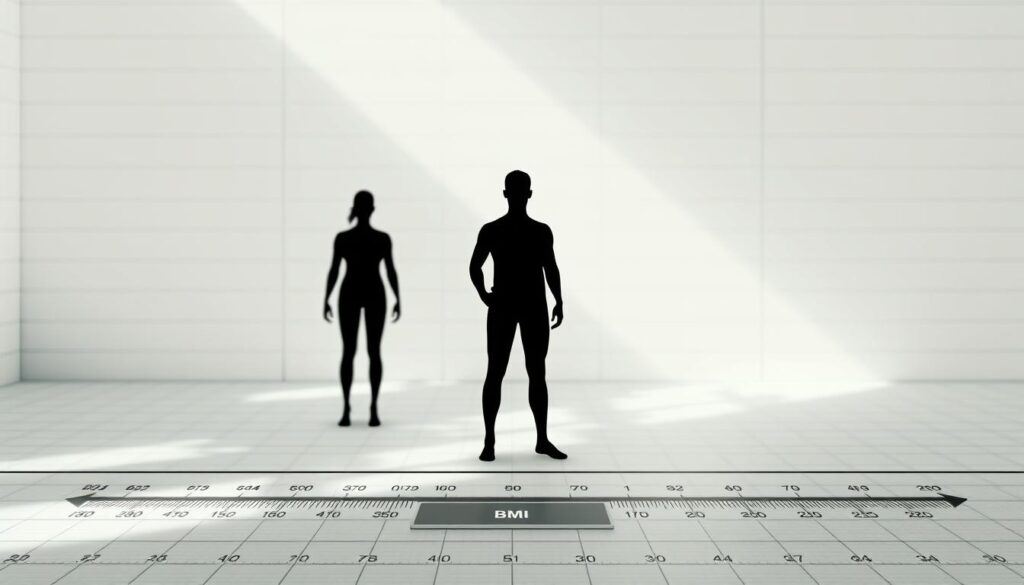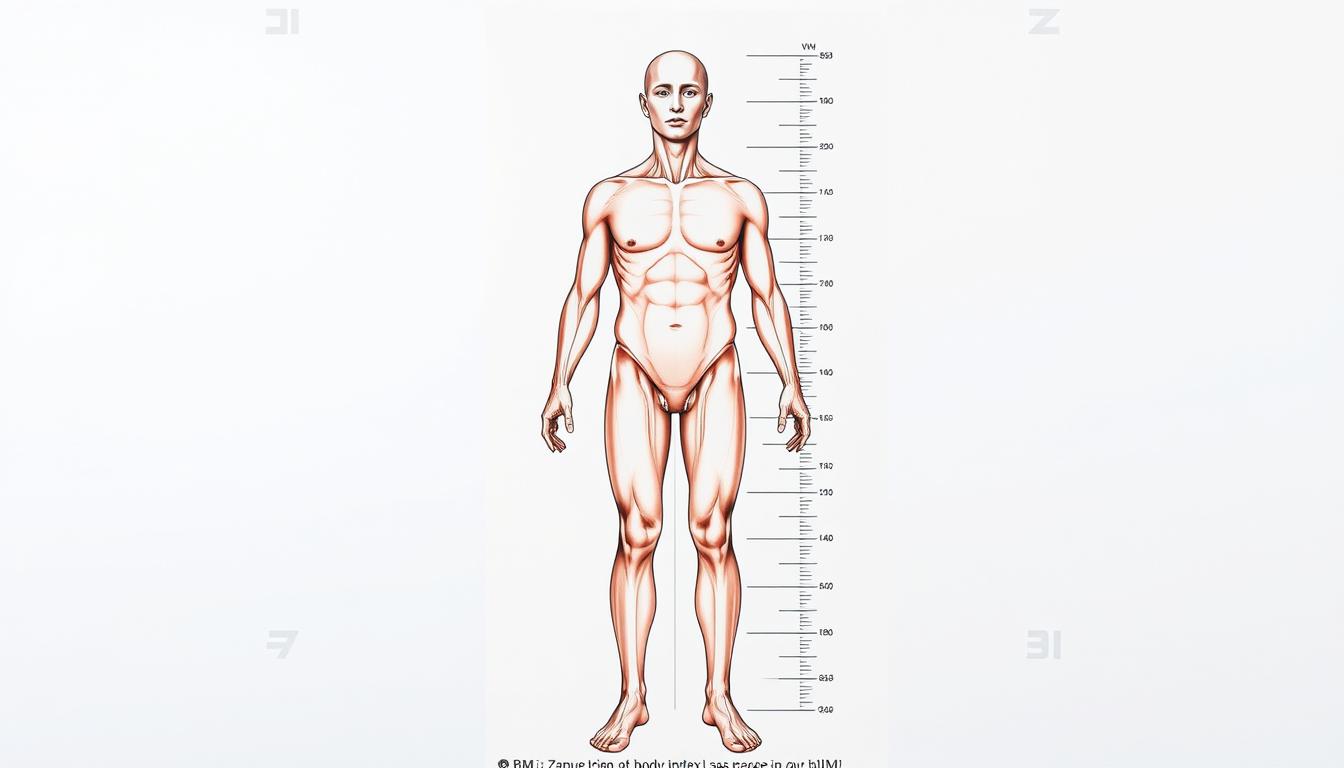For nearly two centuries, the Body Mass Index (BMI) has been around. But, its use as a health metric has been filled with controversy. It was first created by Adolphe Quetelet in 1832 as the Quetelet Index. It wasn’t until 1972 that Ancel Keys coined the term BMI.
Despite its wide use, BMI criticisms have grown. This is because BMI can’t tell the difference between muscle and fat. We look into the history and flaws of BMI, shedding light on its shortcomings.
We will dive into the criticisms and possible alternatives to BMI. This will help us better understand its role in health assessments.
Key Takeaways
- The concept of BMI has been around for nearly two centuries.
- BMI has several limitations, including its inability to distinguish between muscle and fat mass.
- Criticisms of BMI have grown due to its limitations.
- Alternatives to BMI are being explored for more accurate health assessments.
- The history of BMI is marked by controversy and debate.
Introduction to Body Mass Index
BMI, or Body Mass Index, is a common way to measure weight and height. It’s found by dividing your weight in kilograms by your height in meters squared. This simple formula shows if you’re underweight, normal, overweight, or obese.

What is BMI?
Body Mass Index has been used for over a century to check weight status. It’s simple but has its critics. They say it doesn’t account for muscle, bone density, or body composition well.
To calculate BMI, you divide your weight in kilograms by your height in meters squared. This method doesn’t tell the difference between muscle and fat. This can lead to inaccurate assessments for athletes with a lot of muscle.
Brief History of BMI
Adolphe Quetelet first came up with BMI in the 19th century. Ancel Keys renamed it BMI in 1972. Since then, it’s been a key tool in health checks around the world.
Knowing the history of BMI helps us understand its development and why it’s so popular. Despite its flaws, BMI is still widely used because it’s easy to calculate.
Purpose of BMI in Health Assessments
BMI’s main goal is to quickly check weight status. It’s a first step to spot health risks from being underweight, overweight, or obese.
Even with its drawbacks, BMI is still useful in studies and public health efforts. It helps group people and spot trends. This information guides health policies and actions.
The Development of BMI and Its Limitations
In the 19th century, Adolphe Quetelet started working on BMI. He wanted a simple way to measure body mass relative to height. But, this simplicity has been criticized.
Origins in the 19th Century
Adolphe Quetelet, a Belgian mathematician, first came up with BMI. He aimed to categorize people based on weight and height. Studies on PMC show BMI’s popularity in health assessments.
Simplistic Formula: Weight and Height
BMI is simple: weight in kilograms divided by height in meters squared. This makes it easy to use online tools like the BMI calculator. But, it doesn’t consider body composition or muscle distribution.

The limitations of BMI are clear when looking at athletes. They might have a high BMI without being overfat, thanks to their muscle. This shows a big flaw in the BMI calculation, as it doesn’t tell the difference between muscle and fat.
Lack of Consideration for Body Composition
BMI doesn’t look at body composition. It treats all weight the same, whether it’s muscle or fat. This can lead to wrong conclusions, like athletes being seen as overweight.
- Athletes may be classified as overweight due to their muscle mass.
- Older adults may have a normal BMI but still have a high percentage of body fat.
- Individuals with a muscular build may be misclassified as being at a higher health risk.
These examples show we need more detailed health measures. By understanding the shortcomings of BMI, we can look for better health metrics.
Critiques of BMI as a Health Metric
The Body Mass Index (BMI) is widely used but faces many criticisms. It’s simple and quick, but it has big flaws. These flaws can lead to wrong health assessments.
Overemphasis on Weight
One big problem with BMI is its overemphasis on weight. It ignores important health factors like body composition and fat distribution. For example, athletes with lots of muscle might be seen as overweight or obese by BMI, even if they have very little body fat.
Health experts say BMI doesn’t measure body fat directly. It also doesn’t consider how fat is distributed in the body. This is a key factor in health risks.
“The simplicity of BMI is also its major limitation, as it fails to distinguish between lean body mass and body fat.”
Inaccuracy Across Different Demographics
BMI isn’t accurate for everyone. For instance, people of South Asian descent might have more body fat at the same BMI as Europeans. This shows we need better health tools.
| Demographic Group | BMI Category | Average Body Fat Percentage |
|---|---|---|
| European Descent | 25-30 | 25% |
| South Asian Descent | 25-30 | 30% |
| African Descent | 25-30 | 28% |
Misleading Interpretations of BMI Categories
The BMI categories are also criticized for being misleading. They don’t consider muscle mass and body composition. For example, a very muscular person might be seen as obese by BMI, even with low body fat.

We need to think about these issues when using BMI. By knowing its flaws, we can aim for better health assessments. Ones that look at more factors than just weight.
Alternative Measures of Health
Beyond BMI, there are several alternative measures that provide a more nuanced understanding of health risks. The limitations of BMI are significant. Alternative metrics can offer a more comprehensive assessment of an individual’s health.
Waist-to-Hip Ratio
The Waist-to-Hip Ratio (WHR) is a simple yet effective measure. It calculates the ratio of waist circumference to hip circumference. This metric provides insight into fat distribution and is recognized as a significant indicator of cardiovascular risk.
A higher WHR is associated with a greater risk of health issues. Making it a valuable tool in health assessments.
Body Fat Percentage
Body Fat Percentage (BF%) is another metric that offers a more detailed understanding of body composition compared to BMI. By measuring the percentage of body fat, BF% provides a clearer picture of health risks associated with excess fat.
This measure is useful as it differentiates between lean body mass and fat mass.
Other Health Indicators
In addition to WHR and BF%, other health indicators are crucial in assessing overall health. Blood pressure, lipid profiles, and blood glucose levels are important. These metrics, when used in conjunction with alternative measures like WHR and BF%, provide a holistic view of an individual’s health status.
| Health Metric | Description | Health Risk Indicator |
|---|---|---|
| Waist-to-Hip Ratio | Ratio of waist to hip circumference | Cardiovascular risk |
| Body Fat Percentage | Percentage of body fat | Obesity-related health risks |
| Blood Pressure | Pressure of blood against artery walls | Hypertension, heart disease |
By incorporating these alternative measures into health assessments, healthcare professionals can gain a more accurate understanding of a patient’s health risks. They can then develop targeted interventions.
Conclusion: The Future of Health Assessment
Looking back, using BMI alone is not enough. It misses important details. We need to look at body composition and fat distribution too.
Advancing Health Metrics
Using waist-to-hip ratio and body fat percentage can give a clearer picture. These methods help doctors create better plans for each person.
Future Directions
New ways to measure health will come as we learn more. A holistic approach will help us go beyond BMI. This will lead to better care and health for everyone.


